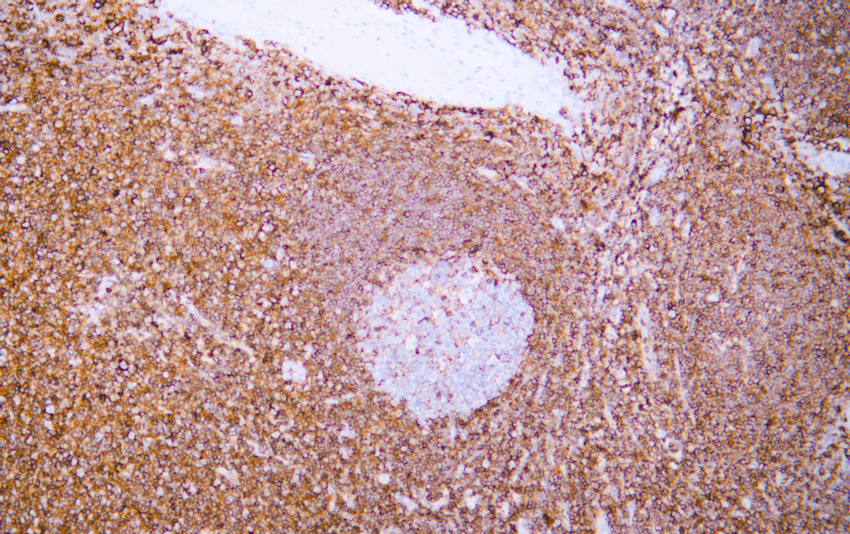CD44 (ABT476) IHC kit
- Catalog No.:IHCM6035
- Applications:IHC
- Reactivity:Human;Mouse;Rat;
- Target:
- CD44
- Fields:
- >>ECM-receptor interaction;>>Hematopoietic cell lineage;>>Shigellosis;>>Epstein-Barr virus infection;>>Proteoglycans in cancer;>>MicroRNAs in cancer
- Gene Name:
- CD44 LHR MDU2 MDU3 MIC4
- Protein Name:
- CD44
- Human Gene Id:
- 960
- Human Swiss Prot No:
- P16070
- Immunogen:
- Synthesized peptide derived from human CD44 AA range: 100-200
- Specificity:
- The antibody can specifically recognize human CD44 protein.
- Source:
- Mouse, Monoclonal/IgG1, kappa
- Purification:
- The antibody was affinity-purified from ascites by affinity-chromatography using specific immunogen.
- Storage Stability:
- 2°C to 8°C/1 year
- Other Name:
- CD44 antigen (CDw44;Epican;Extracellular matrix receptor III;ECMR-III;GP90 lymphocyte homing/adhesion receptor;HUTCH-I;Heparan sulfate proteoglycan;Hermes antigen;Hyaluronate receptor;Phagocytic glycoprotein 1;PGP-1;Phagocytic glycoprotein I;PGP-I;CD antigen CD44)
- Background:
- The protein encoded by this gene is a cell-surface glycoprotein involved in cell-cell interactions, cell adhesion and migration. It is a receptor for hyaluronic acid (HA) and can also interact with other ligands, such as osteopontin, collagens, and matrix metalloproteinases (MMPs). This protein participates in a wide variety of cellular functions including lymphocyte activation, recirculation and homing, hematopoiesis, and tumor metastasis. Transcripts for this gene undergo complex alternative splicing that results in many functionally distinct isoforms, however, the full length nature of some of these variants has not been determined. Alternative splicing is the basis for the structural and functional diversity of this protein, and may be related to tumor metastasis. [provided by RefSeq, Jul 2008],
- Function:
- alternative products:Additional isoforms seem to exist. Additional isoforms are produced by alternative splicing of 10 out of 19 exons within the extracellular domain. Additional diversity is generated through the utilization of internal splice donor and acceptor sites within 2 of the exons. A variation in the cytoplasmic domain was shown to result from the alternative splicing of 2 exons. Isoform CD44 is expected to be expressed in normal cells. Splice variants have been found in many tumor cell lines. Exons 5, 6, 7, 8, 9, 10, 11, 13, 14 and 19 are alternatively spliced. Experimental confirmation may be lacking for some isoforms,function:Receptor for hyaluronic acid (HA). Mediates cell-cell and cell-matrix interactions through its affinity for HA, and possibly also through its affinity for other ligands such as osteopontin, collagens, and matrix metalloproteinases (MMPs). Adhesion with
- Subcellular Location:
- Membranous
- Expression:
- Isoform 10 (epithelial isoform) is expressed by cells of epithelium and highly expressed by carcinomas. Expression is repressed in neuroblastoma cells.
- June 19-2018
- WESTERN IMMUNOBLOTTING PROTOCOL
- June 19-2018
- IMMUNOHISTOCHEMISTRY-PARAFFIN PROTOCOL
- June 19-2018
- IMMUNOFLUORESCENCE PROTOCOL
- September 08-2020
- FLOW-CYTOMEYRT-PROTOCOL
- May 20-2022
- Cell-Based ELISA│解您多样本WB检测之困扰
- July 13-2018
- CELL-BASED-ELISA-PROTOCOL-FOR-ACETYL-PROTEIN
- July 13-2018
- CELL-BASED-ELISA-PROTOCOL-FOR-PHOSPHO-PROTEIN
- July 13-2018
- Antibody-FAQs
- Products Images

- Human tonsil tissue was stained with Anti-CD44 (ABT476) Antibody



